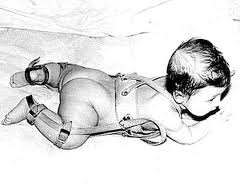 The hip joint includes the articulation of the femoral head (of femur) and the acetabulum of the pelvis. Dislocation occurs when the ball–shaped head of the femur comes out of the cup–shaped acetabulum. Congenital hip dislocation is much more common in girls than boys.
The hip joint includes the articulation of the femoral head (of femur) and the acetabulum of the pelvis. Dislocation occurs when the ball–shaped head of the femur comes out of the cup–shaped acetabulum. Congenital hip dislocation is much more common in girls than boys.
Risk factors:
- Children with a family history of hip dysplasia
- Babies born in breech position
Examination:
The criteria for the diagnosis of congenital dislocation of the hip include both physical and radiographic findings. Dynamic ultrasound is used to assess hip stability and acetabular development in infants and babies under 5 monts. An x-ray of the hip joint may help diagnose the condition in older infants and children.
The Ortolani– and Barlow tests (physical examinations) are the most common clinical tests for newborn babies. These tests are useful in neonates but become difficult by 2-3 months of age.
Physical signs for late dislocation : 
- one leg appears shorter than the other
- include asymmetry of the gluteal thigh or labral skin folds,
- buttock flattening,
- asymmetrical thigh skin folds,
- decreased abduction on the affected side,
- standing or walking with external rotation of the affected leg.
- limited abduction when fully flexed.
- older children may walk limping
Treatment
The principal treatment for Congenital dislocation of hte hip is conservative, especially if diagnosed early. Early diagnosis and treatment is important for a good outcome. In a newborn infant with a good reduction, there is a very good chance of full recovery. The success of treatment depends on the age of the child, and the adequacy of the reduction.
The most important treatment are:
- Physical therapy, it is important to to improve treatment results and to decrease the risk of complications.
- A dynamic flexion-abduction orthosis – Pavlik-harness – left in place at all times, is used to maintain hip reduction. The treatment must be continued until the hip is stable and xrays or ultrasound examinations are normal, but a Pavlik-harness is contra-indicated in children older than 6 months and when the hip is irreducible.
Photo: Sulypont Pain and Rehabilitation Clinic